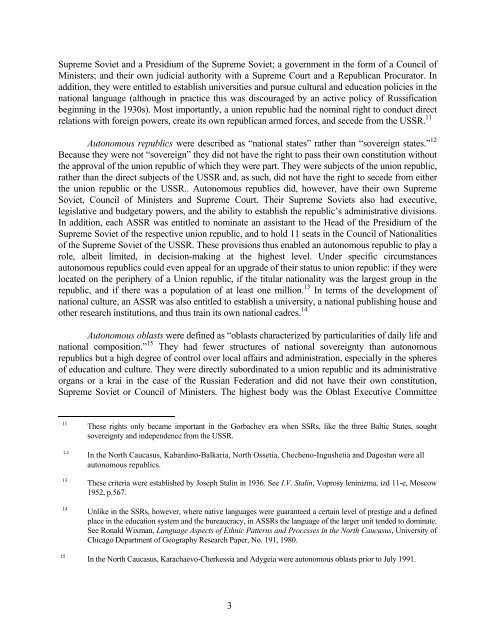RUSSIA'S TINDERBOX - Belfer Center for Science and International ...
RUSSIA'S TINDERBOX - Belfer Center for Science and International ...
RUSSIA'S TINDERBOX - Belfer Center for Science and International ...
Create successful ePaper yourself
Turn your PDF publications into a flip-book with our unique Google optimized e-Paper software.
Supreme Soviet <strong>and</strong> a Presidium of the Supreme Soviet; a government in the <strong>for</strong>m of a Council of<br />
Ministers; <strong>and</strong> their own judicial authority with a Supreme Court <strong>and</strong> a Republican Procurator. In<br />
addition, they were entitled to establish universities <strong>and</strong> pursue cultural <strong>and</strong> education policies in the<br />
national language (although in practice this was discouraged by an active policy of Russification<br />
beginning in the 1930s). Most importantly, a union republic had the nominal right to conduct direct<br />
relations with <strong>for</strong>eign powers, create its own republican armed <strong>for</strong>ces, <strong>and</strong> secede from the USSR. 11<br />
Autonomous republics were described as “national states” rather than “sovereign states.” 12<br />
Because they were not “sovereign” they did not have the right to pass their own constitution without<br />
the approval of the union republic of which they were part. They were subjects of the union republic,<br />
rather than the direct subjects of the USSR <strong>and</strong>, as such, did not have the right to secede from either<br />
the union republic or the USSR.. Autonomous republics did, however, have their own Supreme<br />
Soviet, Council of Ministers <strong>and</strong> Supreme Court. Their Supreme Soviets also had executive,<br />
legislative <strong>and</strong> budgetary powers, <strong>and</strong> the ability to establish the republic’s administrative divisions.<br />
In addition, each ASSR was entitled to nominate an assistant to the Head of the Presidium of the<br />
Supreme Soviet of the respective union republic, <strong>and</strong> to hold 11 seats in the Council of Nationalities<br />
of the Supreme Soviet of the USSR. These provisions thus enabled an autonomous republic to play a<br />
role, albeit limited, in decision-making at the highest level. Under specific circumstances<br />
autonomous republics could even appeal <strong>for</strong> an upgrade of their status to union republic: if they were<br />
located on the periphery of a Union republic, if the titular nationality was the largest group in the<br />
republic, <strong>and</strong> if there was a population of at least one million. 13 In terms of the development of<br />
national culture, an ASSR was also entitled to establish a university, a national publishing house <strong>and</strong><br />
other research institutions, <strong>and</strong> thus train its own national cadres. 14<br />
Autonomous oblasts were defined as “oblasts characterized by particularities of daily life <strong>and</strong><br />
national composition.” 15 They had fewer structures of national sovereignty than autonomous<br />
republics but a high degree of control over local affairs <strong>and</strong> administration, especially in the spheres<br />
of education <strong>and</strong> culture. They were directly subordinated to a union republic <strong>and</strong> its administrative<br />
organs or a krai in the case of the Russian Federation <strong>and</strong> did not have their own constitution,<br />
Supreme Soviet or Council of Ministers. The highest body was the Oblast Executive Committee<br />
11 These rights only became important in the Gorbachev era when SSRs, like the three Baltic States, sought<br />
sovereignty <strong>and</strong> independence from the USSR.<br />
12 In the North Caucasus, Kabardino-Balkaria, North Ossetia, Checheno-Ingushetia <strong>and</strong> Dagestan were all<br />
autonomous republics.<br />
13 These criteria were established by Joseph Stalin in 1936. See I.V. Stalin, Voprosy leninizma, izd 11-e, Moscow<br />
1952, p.567.<br />
14 Unlike in the SSRs, however, where native languages were guaranteed a certain level of prestige <strong>and</strong> a defined<br />
place in the education system <strong>and</strong> the bureaucracy, in ASSRs the language of the larger unit tended to dominate.<br />
See Ronald Wixman, Language Aspects of Ethnic Patterns <strong>and</strong> Processes in the North Caucasus, University of<br />
Chicago Department of Geography Research Paper, No. 191, 1980.<br />
15 In the North Caucasus, Karachaevo-Cherkessia <strong>and</strong> Adygeia were autonomous oblasts prior to July 1991.<br />
3
















